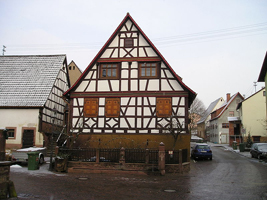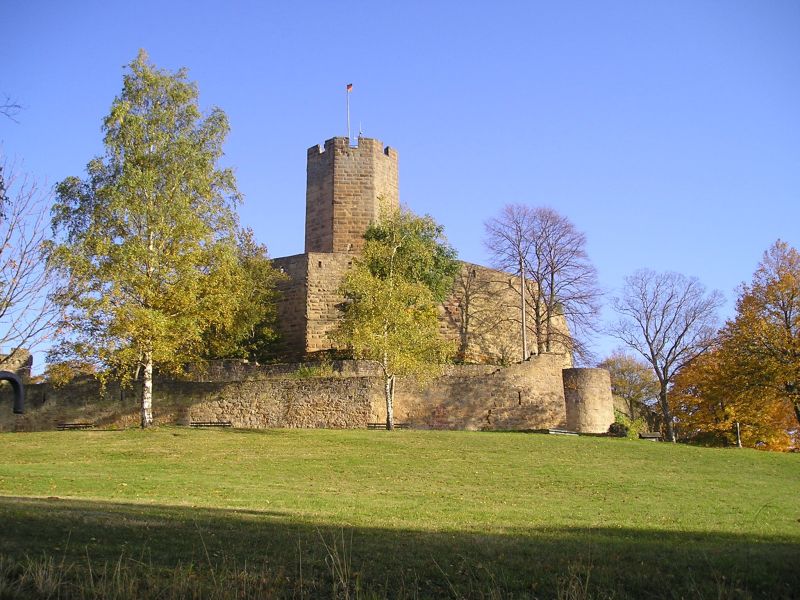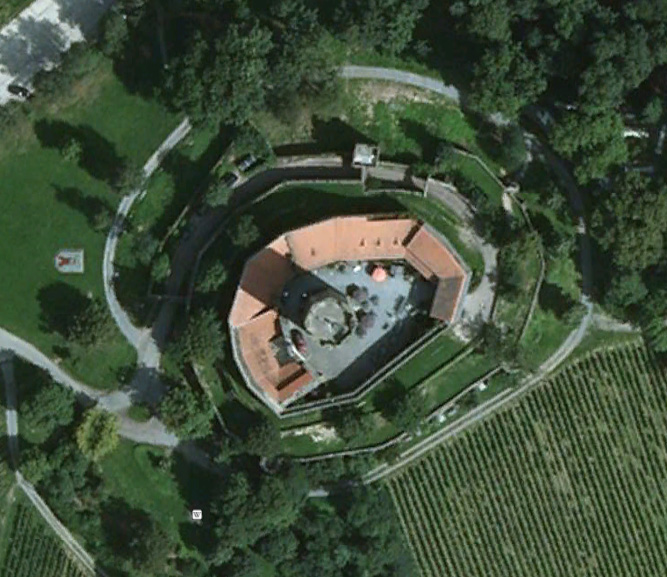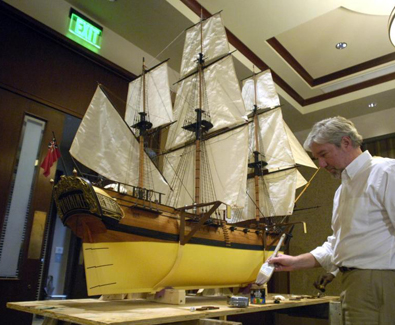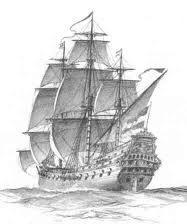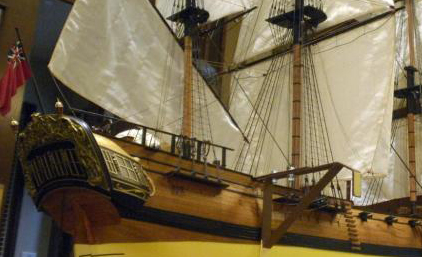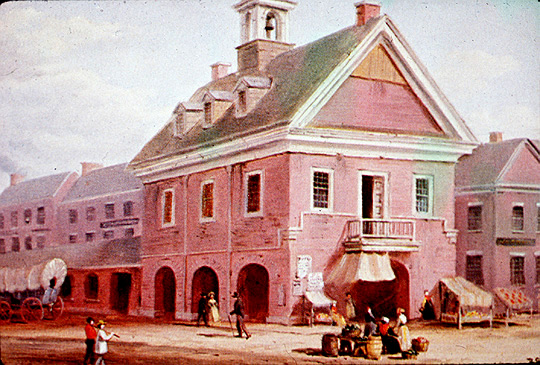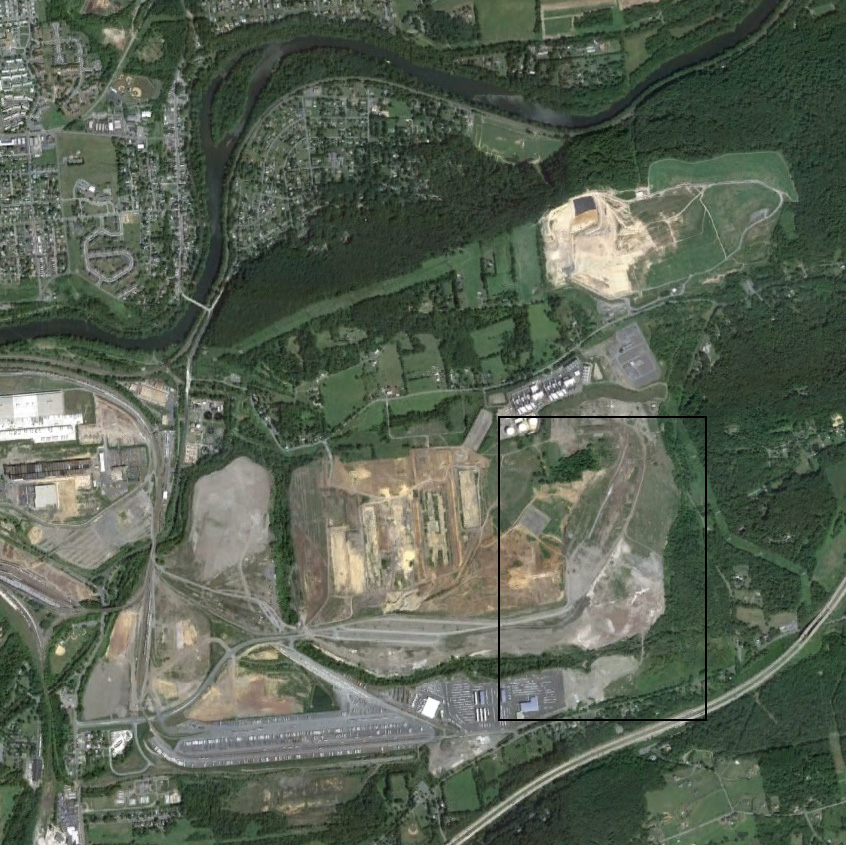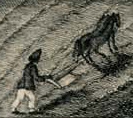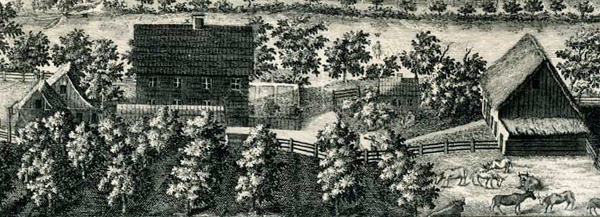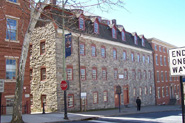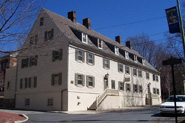|
1727 Immigrant From Germany To America
Preface: The object of this web page is to show the life and times of Hans Georg Hertzel - what his life was like, the people around him, things he saw, maps, pictures, etc. It uses the work of Hannah Benner Roach, Charles H. Price Jr., Paul R. Swan, and others, plus my own augmenting research (as a late-comer I had the advantage of Google). It is extremely fortunate for us that Hannah Roach, in her search for the parents of her ancestor Maria Gross, was led to the Hertzel family, and took the time to publish "Hans Georg Hertzel, Pioneer of Northampton County, and His Family" in 1965. Birth & death: Hans Georg Hertzel was baptized July 30, 1686. He was the second son of Clemens Hirtzel who married January 23, 1680/1681. Hans Georg's 1686 birth year looks reasonable. His grandson Jonas Hartzell's 1816 letter says Hans George died February 1755. In the letter, Jonas said he (Jonas) was born in 1741 and was 14 years old when his grandfather was buried.
(With links to Paul Swan's Hartzell Chapter and Jim's detail pages.) » Hans Georg Hertzel » Hans Jacob Hertzel » Johann Philip Hartzell » Adam Hartzell (Adam-David link proven by Y-DNA match between myself and a descendant of Adan's sons John & Leonard.) » David Hartzell » James Alexander Hartsell » James Oran Hartsell » James Daniel Hartsell » James Dwight Hartsell Hans Georg Hertzel's great-grandfather was Jacob Hirzel ("Hirtzel"), born about 1580 in Pfäffikon Parish, Zürich, Switzerland, when Galileo and Shakespeare were both 16 years old. In 1607 Jamestown, Virgina was founded, and the Jamestown Massacre was in 1622. Jacob died in Pfäffikon before 1634, before age 54. Hans Georg's grandfather was Heinrich Hirzel ("Hirtzel"), born in 1619 in Pfäffikon Parish. He and his family emigrated 140 miles due north to Germany about 1653, 23 years before Hans Georg was born. Heinrich died in 1663 in Reihen, Baden, The Palatinate, Germany, at age 44. Baden is a historical state on the east bank of the Rhine River in the southwest of Germany. Reihen is a town in what is now Baden-Württemberg (state) of Germany, about 18 miles due southeast of Heidelberg. The Palatinate is an area of Germany where Swiss Mennonite refugees settled after 1650. See Hartzell Narrative [4] for interesting details. For a large drawing of 1620 Heidelberg, Germany, click here. Homes in Reihen should have looked much like homes in Heidelberg. Hans Georg's father was Clemens Hirtzel, born in 1659 in Reihen. Clemens' father died when Clemens was 4 years old. From Swan[2], Clemens' godfather was the Rev. Clemens Hirzel, Pastor of the Reihen Evangelishe Kirche (Reformed Church), starting his pastorate in 1651. The pastor had emigrated from Winterthur, north of Pfäffikon, and may have headed the emigration from that area of Switzerland to Reihen in 1653. This emigration included our ancestor Clemens' father Heinrich, where Clemens was born 6 years later, and the pastor stood as godfather to Clemens. In 1680, Clemens Hirtzel married Anna Sinter, the midwife of the community. Until the time of his death, according to Roach[1], Clemens was a subject of the von Venningen family, and was their administrator, or bailiff. Below shows the location of Reihen (marked bottom right) 18 miles southeast of Heidelberg. Reihen is just southeast of Sinsheim. Our ancestors were here for 74 years.
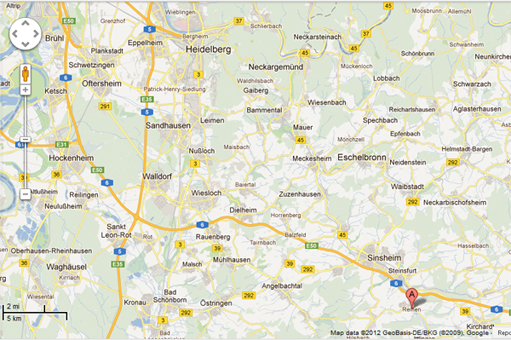
Our ancestor Hans Georg Hertzel, second son of Clemens, was born in 1686 in Reihen, Germany. Reihen is now considered a suburb of Sinshiem. A year after Hans Georg's birth, Isaac Newton published his "Principia Mathematica".
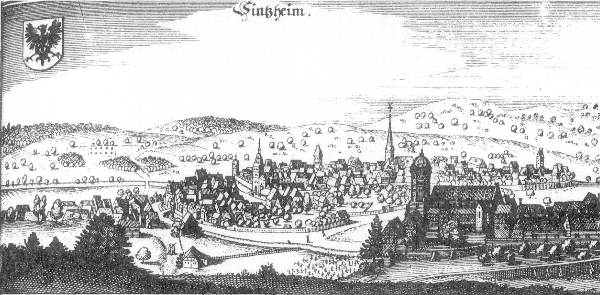 Sinsheim, Germany, in the 1600's. In 1689, when Hans Georg was 3, most of Sinsheim was burned to the ground by Ludwig XIV's troops, but was quickly rebuilt. At the lower right of the drawing above, there is the Franziskanerkloster (Franciscan Monastery), still standing today.
When Hans Georg was 7, Heidelberg was attacked and burned by the French, and Heidelberg Castle was destroyed. There was endless warfare. In Reihen and neighboring towns, bear in mind that Hans Georg had many uncles & aunts, and many cousins. As a child he must have played with these cousins. When Hans Georg was 16, it was the first of six deaths in his family within the next 12 years. His little sister Maria Margretha died in 1702 at the age of 3. When Hans Georg was 21, his father Clemens died in 1707 at age 48 in Reihen during the "Little Ice Age" in Europe. This must have been financially devastating for the family. When Hans Georg was 22, his brother Johann Jacob, the twin of Maria Margretha who died in 1702, died in 1709 at the age of 9. The coldest cycle of the Little Ice Age in Europe was between 1680 and 1730, which included Hans Georg's entire life there. There were very cold winters and short growing seasons in the summer. The winters of 1683-84 and 1708-09 were exceptionally cold. Crops failed and cattle died by diseases caused by the weather. Famine followed famine causing epidemics, bread riots, and general disorder. It caused a heavy toll on Hans Georg's siblings, with five out of nine dying young. In 1693, when Hans Georg was 7, there was the Great Famine in France, where 2 million peopled died.
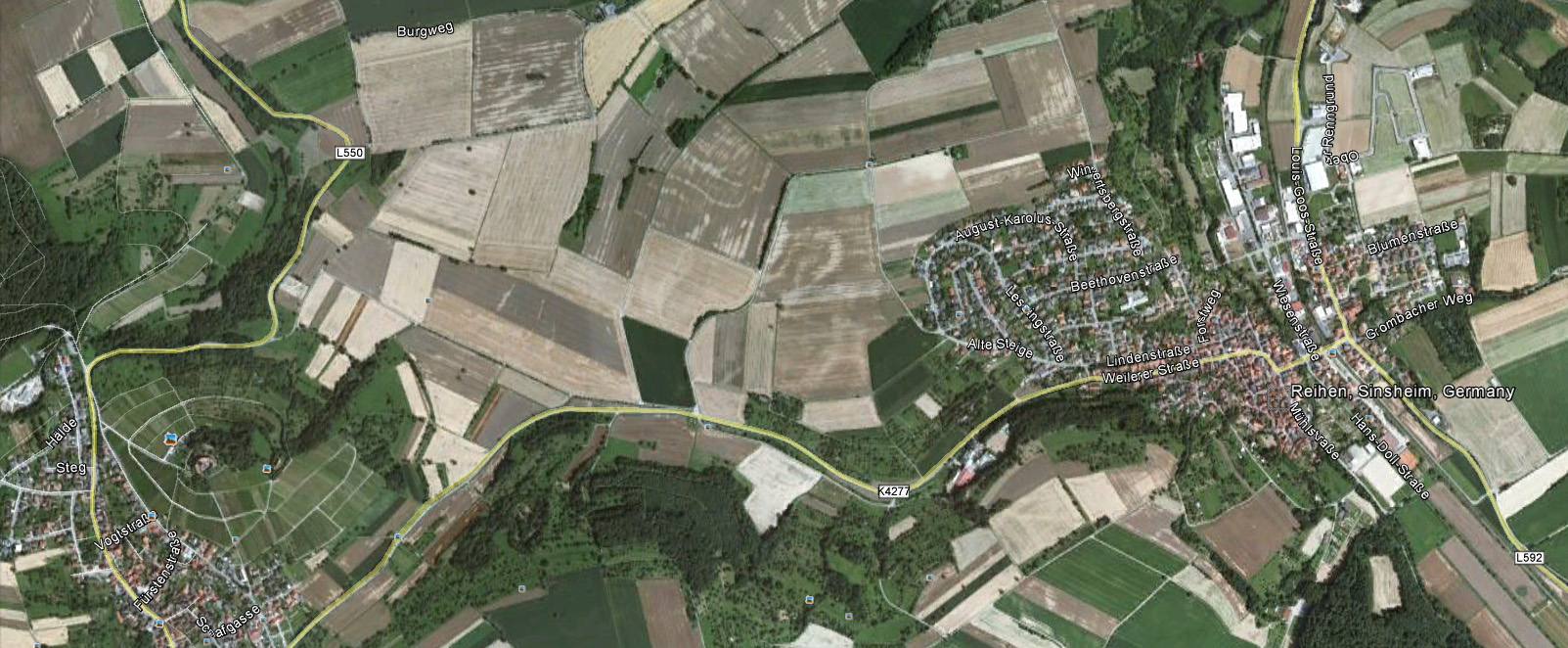 Steinsburg Castle - Reihen proximity. From Google Maps 2012
Hans Georg Hertzel, at age 27, married Anna Margaretha Conrad in 1713, in Reihen. Anna was born about 1690 in Reihen, the daughter of Jacob Conrad. Very little is known of her. Some accounts say she died before or during the trip to America. The ship's list shown below says she arrived alive. Hans Georg was by now self-sufficient to marry.
In 1714, when Hans Georg was 28, his first son was born, Hans Georg (Jr.). In the same year his brother and two sisters died: Maria Ester, age 26, who had been married 3 years; Hans Jonas, age 20; and Anna Christina, age 17. By 1715, Hans Georg's surviving siblings and mother were: Mother Anna, born 1690 (died 1738 in Reihen), Hans Heinrich Hirtzel, bap. 1681, Christoph "Stoffel" Hirtzel, bap. 1690, Anna Margretha Hirtzel, bap. 1702, and Hans Ulrich Hirtzel, b. 1705. In 1716, when Hans Georg was 30, son Hans Jacob Hertzel, our ancestor, was born. In 1719, daughter Anna Margretha was born. In 1722, son Johann Dietrich was born. In 1724, son Johann Leonard was born. About 1725, Hans Georg's younger brother Ulrich took a ship to Philadelphia at around age 20. This is an example of the common practice that a young, unmarried son of the family would scout out the land, then return to the homeland to report his findings, possibly take a wife, as did Ulrich, and guide the rest of the family to the new country. Hans Georg was now about 39. In this around-1725 trip, Ulrick played a major role in our ancestor's move to America. Somehow he made it to Skippack, an already established German settlement 25 miles northwest of Philadelphia. The first settlers had arrived in 1708. There was certainly a well-marked trail by now. Skippack is in what is now Perkioman Township, Montgomery County, PA. Skippack was an outgrowth of the Germantown settlement near Philadelphia. We don't know how long Ulrich was in this area before his return to Germany. Everyone was German, so everyone spoke German. Ulrich was to make 3 crossings, and must have had the money to pay for them.
In 1727, the year Isaac Newton died, the Hans Georg Hertzel family sold their possessions. It was a major sacrifice, and literally a matter of survival, with conditions being so bad in Germany. The trip up the Rhine, with constant tolls, may have sapped their finances. With all the jurisdictions, and delays at each one, this trip could take up to six weeks. Then there was a delay in Rotterdam waiting for favorable winds.
 Rotterdam Harbor, 1750. This would be how Hans Georg saw it. In Rotterdam they boarded the "William and Sarah", William Hill the captain, to a stop in Dover, England, and then on across the Atlantic to Philadelphia. Changed 3/23/12: For what the William & Sarah looked like, I found the web page m.savannahnow.com/news/2007-12-08/model-ship-represents-jews-1733-voyage. The first Jewish settlers in Savannah, Georgia arrived on the William & Sarah in 1733. Rabbi Mark Belzer of Mickve Israel began research on this ship in 1991. An 8-foot replica was created by the American Marine Model Gallery and finished in 2008. It cost around $30,000. The web page says that blueprints have not been found, and claim it was a British cargo ship. Artist Richard S. Granville used drafts of a similar ship of the era. It is believed to have been 24 times the size of the model, which would be 192 feet long. Travel would have been fairly roomy. From Belzer's research, I trust that this is probably what the ship looked like. I think the ship was a British East Indiaman ship, which was used for passengers and cargo.
The model below looks like the Thistle of Glasgow drawing at right.
For very detailed pictures of a model of the 1740 English East Indiaman Prince of Wales, see www.modelships.de/Eastindiaman_Prince_of_Wales/Eastindiaman_1740.htm. Some pictures below are from Zeigler[3], on George Philip Ziegler, who was also on the 1727 ship.
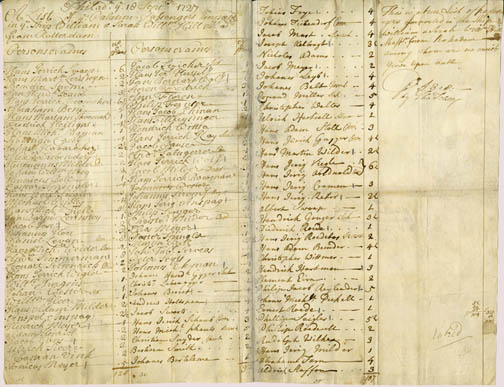 Ship's list, William & Sarah, 1727. Hans Jerg Hertzel is in 2nd column, 2nd name. Heading the list of passengers was Georg Michael Weiss, a young minister who came with the immigrants as their pastor. He became the first pastor of the New Goshenhoppen Reformed Church, located west of the present East Greenville, Montgomery County, PA. The list shows 4 freights, not persons, for the Hans Georg family. Children 4-15 were counted as half-freights, and children under 4 were free. Thus we can account for the entire family, including Margretha, who some think died before or during the journey. The list does not show her as dead. See www.progenealogists.com/palproject/pa/, 1727 William & Sarah. Their ages were Hans Georg Hertzel, 41, Margretha (Conradt), Hans Georg, 13, Hans Jacob (our ancestor), 11, Anna Margretha, 8, Johann Dieterich, 6, Johann Leonard, 2. On board was younger brother Hans Ulrich & his wife. Also on board was Hans Georg's sister Anna Margretha & her husband Johannes Liepp. There were two other relatives, Dietrich and Hans Ernst Rudi & their families. They may have thought they would see their families again, but apparently never returned. They were on a ship with 400 or so people crowded aboard. Typhoid, Yellow Fever, and other diseases of cramped spaces without enough clean water affected many of the ships. There were rats, lice, and bad food. But, only 4 people died on this trip, below average for the times. For a fascinating 1750 account of a ship journey, see www.jdhartsell.com/HansGeorg/ship_journey.html. We don't know who paid their passage on arrival. It is remarkable that all of Hans Georg's children survived all that they had been through.
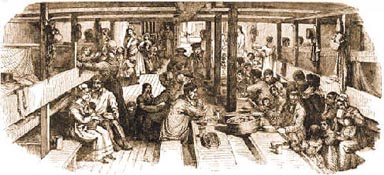 Emigrant ship interior of the period. When the family arrived in Philadelphia Sept. 18, 1727, Benjamin Franklin, 21, had a print shop in Philadelphia. George Washington was 4, and Thomas Jefferson was 16.
Below is the Oath of Allegiance signed by Hans Georg Hertzel, Sept. 21, 1727. He signed it "hans Jerg hertzel", but so far I haven't found it.
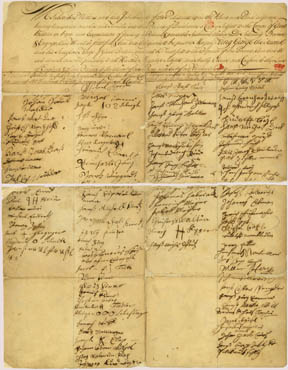 www.genealogystories.net/georg_philip_immigrant.html Since the Hans Georg family arrived in Philadelphia Sept. 18, I would guess they wintered in Skippack. See below for more on this. Pioneer diet was potatoes, corn, berries, fish, and game.
Swan[2] reports that "Hans Georg settled first in an area some thirty miles north of Philadelphia, and soon afterward, by a decree of the court in 1728, this area was organized as Salford Township, Philadelphia county". But, it gets confusing here. There was a Jorg Hertzel and Ludwig Hertzel who arrived in Philadelphia on the ship Thistle of Glasgow, qualifying Aug. 29, 1730. In 1730, a George Hertzel and Ludwig Hertzel arrived in what was then Salford Township[5]. Swan[2] found a petition signed by a Hans Georg in 1731 for the establishment of part of Salford Township, Philadelphia County (later Montgomery County) as a new township called Franconia. Swan says that this petition is the only record we have of Hans Georg in that location. In 1734 a George Hartzell owned 100 acres in Franconia Township and was one of the 34 taxable individuals in the township[5]. So, at this point, I'm not sure if our Hans Georg lived in Salford/Franconia Township. His brother Ulrich Hertzel was still in Skippack Township in 1733[6], as a member of the Goshenhoppen Reformed Church. There is no mention of Hans Georg. Hans Leonhart Hertzel became a member in 1737 [6]. He arrived in Pennsylvania Sept. 21, 1732. The part of Salford Township that became Franconia Township would narrow where Hans Georg lived, but Franconia township is surrounded on the west and south by Salford, Lower Salford, and Upper Salford townhips. Hans Georg (?) must have lived in the area of the towns Harleysville, Hatfield, Telford and Souderton, in what would have been the northeast quarter of the original Salford Township. In 1732, more of the family arrived on the ship "Pink Plaisance". They were Hans Georg's brother Hans Heinrich Hirtzel & family. They settled in the Skippack area by 1736, which could indicate Hans Georg was still in this area. This now made 3 brothers and 1 sister in Pennsylvania. Remaining in Germany was their mother (died in 1738) and their brother Christoph (died 1734). Also on the ship were cousins Hans Paul Hirtzel and Hans Heinrich Hirtzel with their families.
About 1734 Hans Georg (?) sold his land in Franconia Township[4]. In 1735, in partnership with Nicolaus Transue, he was warranted 300 acres, presumably by William Penn's sons, 20 miles farther north in what would become Lower Saucon Township, Northampton County, PA. I have not found any information on Nicolaus Transue, but there was an Abraham Transu on the ship Thistle, along with George and Ludwig Hertzel mentioned above. There were no roads to this land. The 300 acres, almost one-half square mile of land, was on the East Branch of Saucon Creek, south of the Lehigh River, and east of the future site of the town of Bethlehem. This land is now partially covered by the slag dump of Bethlehem Steel Company (a Google Earth image is below). Members of the (German) Reformed Church living in the Saucon area were described in 1734 by pastor John Philip Boehm as "the poor sheep at the end of the wilderness" having no settled pastor to minister to them and no money to support one. "It is a somewhat out of the way place", he said. So inaccessible was this corner of what was then Bucks (now Northampton) County that it was visited only at rare intervals by the few pastors from the more settled parts near Philadelphia. In 1747 the congregation in Saucon was meeting at "Hertzel's", the dwelling of Hans Georg Jr. Below, Hans Georg's 300 acres is on the right, warranted 3 Apr 1735, and surveyed 24 Dec 1737. It was about 3 miles east of the future site of the town of Bethlehem and inside the Walking Purchase of 1737. From the warranted dates of his neighbors, Hans Georg was the first settler. The Road to Irish's Mill (on N. Irish's land) might now be Shimersville Road. Hans Georg's land was surrounded by hilly land on the north, east and south. Note son Jacob's 1749 land and son Leonard's 1751 land north of Hans Georg's.
See USGS map at www.usgwarchives.org/maps/pa/county/northamp/usgs/lowsauco.jpg.  Map shows present-day Hellerton (Easton) Road, and Applebutter Road which did not exist in 1737. There are still some old stone houses along Applebutter Road. Maybe one was Jacob's or Leonard's. Below is how the area looked in Aug. 2010 (Google Earth). All of this was forest in 1735. The location of Hans George Hertzel's land is shown, based on the drawing above. There seems to be more green and less slag than before. I think his dwelling was probably in the southwest corner, south of but close to Saucon Creek. The land was approximately 185 perches by 260 perches, which is 3,050' (0.58 mile) by 4,290' (0.81 mile). Saucon Creek runs horizontally about 1/5 up the left (west) side. The freeway at the bottom right is Interstate 78. Just above it is Easton ("Hellertown") Road. I would expect that Hans Georg and his older sons went up to their new land to build a log cabin before the family move. One or more other men may have joined them, perhaps a brother or two. They must have walked the 20 miles through the woods, probably following Indian traces and a crude map, and sleeping in the woods at night. They would have taken axes, saws, shovels, a tarp for a crude shelter, food, etc. They must have had a pack horse. They were probably gone for a month. They would have used a crude shelter and campfire all the time they were building the log cabin. It surely rained. Pioneers built a log cabin first because it was faster. They tended to replace them with larger log or stone houses. They made lime mortar by burning limestone in makeshift kilns. At first they used thatched roofs on their stone houses. All cooking and heating was provided for by a fireplace. Hans Georg's initial log cabin was probably small (16' x 18'). It was surely enlarged later to accommodate his large family, plus visting relatives. It could very well have looked like the picture below. It is the still-standing Zufluchtshaus (Shelter House) in Lehigh County, built in 1734, and 10 miles southwest of where Hans Georg lived. He may have seen this house. The house is an example of the European continental log house style, with a fireplace in the center, and was enlarged twice. The house is in Emmaus, just south of Allentown.
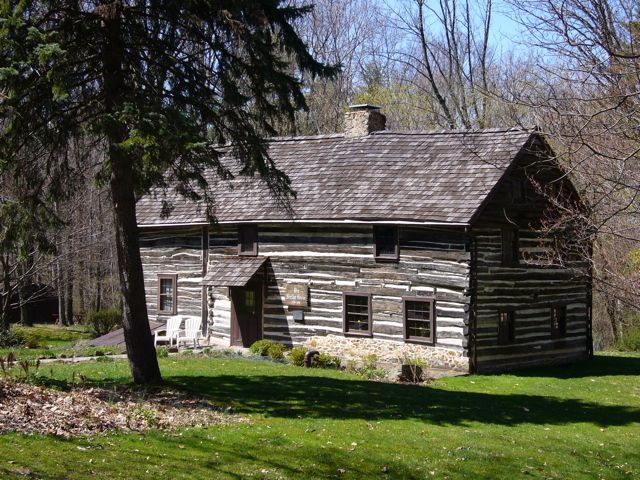 From www.lehighcountylogcabintrail.org/content/shelter-house%E2%80%A0 In 1735, starting life on their new and remote land, Hans Georg was about 49, his wife Anna Margaretha was about 45 (some references say Anna died before or during the ship journey, but the ship list accounts for her presence, and does not state that she died). Their oldest son Hans Georg Jr. was about 21, Hans Jacob (our ancestor) was about 19, Johann Dietrich was about 13, and Johann Leonard was about 9 years old. The family surely spoke only German. (Hans Georg's grandchildren, for sure our ancestor Johann Philip, could speak, read and write English.) There was no doctor. They started fires with flint & steel, and probably kept the fireplace going all the time - there was plenty of firewood. As mentioned above, Hans Heinrich, Hans Georg's older brother by 5 years, arrived in Philadelphia in September, 1732, on the ship Pink Plaisance. With him was his wife Anna Barbara, daughter Anna Christina 27, son Leonard 24, possible son Urigg 18, and daughter Jacobina 15. The family settled in the Skippack area by 1736 and were associated with the Reformed Church there. Daughter Anna Christina married George Peter Knecht, and they later settled near her uncle Hans Georg in Lower Saucon Township, Northampton County, PA. Son Hans Leonard & wife Maria Magdalena also settled in Lower Saucon Township. Daughter Jacobina married Paul Leidy of Franconia Township, Montgomery County, and they settled in adjoining Hatfield Township. Hans Georg's brother Ulrich, the one who first explored Pennsylvania, apparently lived in Upper Salford Township, Montgomery County, where he died in 1771. Ulrich's son John George Hertzel was the last slaveholder in Franconia Township.
In June 1742, Lower Saucon Township was laid out, encompassing Hans Georg's land. In 1747, Hans Georg, age 61, sold the southern half of his land to his son-in-law Phillip Schlauch, husband of his daughter Anna Margretha. He had already conveyed the northern half to his original partner, Nicolaus Transue. This implies Hans Georg's house was in the southern half of his land. In 1741, construction began in the new town of Bethlehem, 3 miles west of Hans Georg. But, it was not a regular town. It was to be the religious communal home of the Moravians, here to convert the Indians. In their religion, starting at the age of 18 months, people lived in groups according to their age and sex. In 1742, they built the largest log house in the country. Called the Gemeinhaus (Community Building), it was 94' x 32'. It is now covered with clapboard siding, at 66 W. Church St. The first stone building, the Single Sister's House, was built in 1744. It is still there, at 44 W. Church St. The Single Brethren's house, built in 1748, is at 89 W. Church Street. Hans Georg surely saw these three buildings. The Moravian Chapel was built in 1751 and was attached to the Gemeinhaus. Bethlehem was the nerve center of the North American Moravian empire, and the industrial center. The nearby Moravian agricultural centers were Nazareth, Nain, Lititz, Emmaus, Lebannon, and Hope. Since outsiders were not welcome in Nazareth, I assume so it was for Bethlehem.
Above is a farm that was 3 miles west of Hans Georg, on the Lehigh river, across from Bethlehem. It is shown in the large 1757 drawing below. Since Moravians could not have their own land, this farm must be a settler's, probably after 20 years of habitation. The dark brown building was a tavern in 1757, right across the river from the Moravians! It could have been an Inn, and looks like it was built of logs. To the right of it is probably the original log cabin, with the chimney in the middle in the German style. Farther to the right is the barn. To the left of the tavern must be a stone house that was built later. The buildings other than the tavern all seem to have a thatched roof.
See info and 1766 town map at www.nps.gov/history/Nr/twhp/wwwlps/lessons/59bethlehem/59bethlehem.htm.. For a sharper black & white annotated image, click here, then click on picture that comes up.  Bethlehem, Pennsylvania, 1757 (founded in 1741), on the Lehigh River, looking north,
Bethlehem, Pennsylvania, 1757 (founded in 1741), on the Lehigh River, looking north,3 miles west of Hans Georg Hertzel's land (click on picture).
In the picture above, the large building left of center is the Brethren's House. The larger building
to the right of center is Gemeinhaus, then Sister's House. Below, left
to right is the Brethren's House, the Gemeinhaus (now with clapboard siding), and the Sister's House.
Click on a picture to see these and others in larger size.
See the source for the pictures below at
travel.webshots.com/album/562829273pNanSe?start=0.
To the east in the Lehigh Valley, the town of Easton was first settled in 1739 and founded in 1752. To the west, Allentown was founded in 1751. Hans Georg's son Hans Jacob, our ancestor, married Barbara Ritter around 1740 in Lower Saucon Township. Hans Georg was surely at the wedding. Their son Johann Philip, our first American-born Hartzell ancestor, was born April 20, 1743 in Lower Saucon Township. Hans Georg surely bounced Johann Philip on his knee. Hans Georg died after 1747 in Lower Saucon Township. C.Hartzell says 1755[4], which would match son Jacob's 1755 move to Bethlehem Township, and would have made Hans Georg 69 years old. It is doubtful Hans Georg had a need to learn English. C.Hartzell[4] says his wife Anna Margaretha died Sept. 20, 1796 but she would have been about 106 years old (born about 1690). For an idea of a person's possessions in the middle 1700's, there is an inventory of the estate of Hans Georg's son Hans Georg (Jr.), 1762. 8 cows, 4 heiffers, 2 sucking calves, two bulls & a steer, 4 horses and a mare, 12 sheep, and 8 swine. Hand saw, auger, crosscut saw, drawing knife, 2 axes, 3 plows & irons, iron tooth harrow, grubbing hoes and scythes, 2 beehives, an old plane, swingle tree (swings back and forth behind the horse), dung hooks & dungfork, windmill, wagon with horse gears, and a man's hackney saddle. In the house was a walnut table, 5 beds, dresser, kitchen dresser, some books, lanthorn & tankard, tobacco, wooden stools, looking glass, tea cups, pair of quillers, 2 spinning wheels, iron and earthen pots, kettles, pans, casks & tubs, churn, wool cards and Bels. (Remember that all cooking was done in a fireplace.) For clothing, there was a jacket, a body jacket, leather jacket, 3 pair of leather breeches, linsey jacket, and 2 other jackets. (No rifle or saddle listed.) Hans Jacob moved about 1755 farther north into Bethlehem Township, Northampton County. His land was from present-day central Newburg to the Drylands Churchyard at Hecktown, on the west side of what is now Route 191. Hans Jacob was an innkeeper by 1766 (photo below) at what is now The Newburg Inn, 4357 Newburg Rd., Nazareth. It is not known what the original building looked like. It was enlarged in 1802 and 1941. Since the Inn was built in 1750, and if Hans Georg was still alive, he may have seen this building.
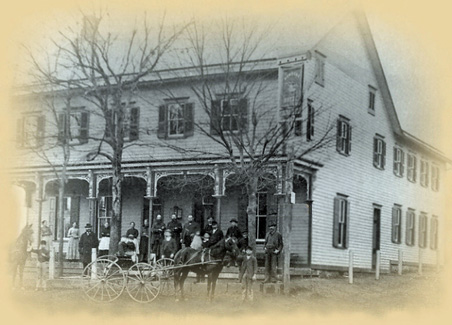 The Newburg Inn, late 1800's. Click picture for 778 x 560 pixel image. By 1772 Hans Jacob turned the Inn over to his son Jonas. He returned to farming, and died in 1781 in Bethlehem Twp. Click here for a YouTube video of the Inn. Hans Georg Hertzel was active with petitions for roads and townships. Surviving petitions in the Sessions files at Doylestown show that Hans Georg Hertzel and his older sons all joined in signing their names to a number of them, thus showing they had a certain amount of education. In one is Hans Georg's signature (Roach, page 157).
On a March 1743 petition to confirm the erection of Lower Saucon Township are the signatures of Hans Georg (Jr.?) and Hans Jacob (Roach, page 160).
For more detail, see the following.
1 Hannah Benner Roach, 1966, "Hans Georg Hertzel, Pioneer of Northampton County
and His Family". (To see this, I had to install Family Archive Viewer on my computer a few years ago.)
Spelling: "Hirzel" in Switzerland (pronounced "Hirtzel"); "Hirtzel" after 1653 move to Reihen, Germany; "Hertzel" on 1727 arrival in Philadelphia; "Hartzell" by 1816; then "Hartsell" by some. | |||||||||||||||||||||
